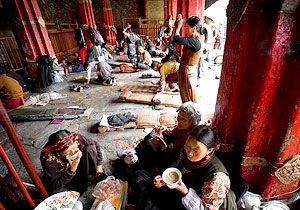Jokhang Temple

Jokhang Temple, located at the Lhasa city center and encircled by the Barkhor Street, is one of the very holy Tibetan Buddhism temples. This over 1300-year-old temple has been listed in World Cultural Heritage in 2000.
The temple was built by the Songtsen Gampo (617-649), the leader of Tibet, originally for housing a Jowa Sakyamuni image brought by his Nepalese wife. But another Jowa Sakyamuni image of other King's wife (the Chinese Tang Dynasty Princess Wencheng) was later moved here and it is this image that earns Jokhang Temple its name and spiritual appeal for Jokhang means 'chapel of Jowa' and this image is the most revered as the intact life-size golden portrait of Jowa Sakyamuni.
It is windowless inside and chapels are lit up with lines of yak utter lamps kept burnt by the endless Tibetan believers. The center with the main statues and chapels on two floors and the intricate frescoes inside the temple are full of fancy Buddhism details and layered in history and significance. The second floor serves as debating site for the monks every afternoon. The debating monks with prayer beads in hand work in pairs or groups. Their rich voice pitches, facial expressions, and body movements make it an interesting sight to see. From this floor, a nice overlook of the city and the Potala Palace is available. The monastery is mainly reserved for pilgrims to pray in the morning (8:30am-11:30am) while for the tourist groups in the afternoon (11:30am-05:30pm) and some chapels will be shut off during the time.
The worshippers' reverence always is more impressive than the temple itself: flocks of worshippers clockwise prostrating along the Barkhor Street to the Jokhang (clockwise worship is believed to be a way to communicate with and get enlightened by the Sakyamuni), and the villagers contented with empting their purse or begging to gild the statues and even the Teeth Pillar full of the teeth or nails that the late trekking pilgrims left for the survival ones to present to the Jokhang Buddha to fully end the pilgrimage journey for them.
Special festivals frequently take place and drench the temple area in the heavy traditional Tibetan festival ambience like the Tibetan New Year, the Butter Lantern Festival (15th day of Tibetan January), and Saga Dawa (15th of Tibetan April) to commemorate the Sakyamuni.